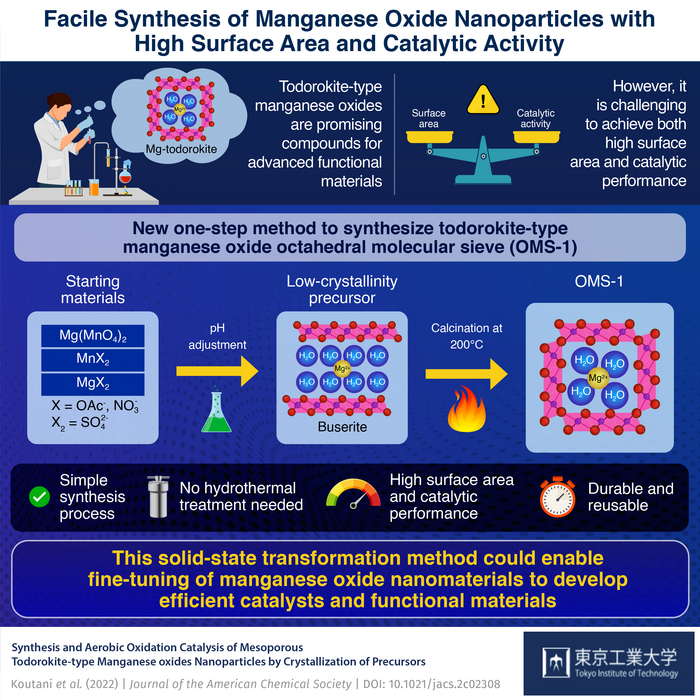Reviewed by Alex SmithJul 26 2022
Manganese oxides have received much attention from materials scientists due to their widespread application in electrodes, catalysts, sensors, supercapacitors, and biomedicine. Manganese is also widely abundant and has many oxidation states, which allow it to form various interesting crystalline structures.

Image Credit: Tokyo Tech
The “todorokite-type manganese oxide octahedral molecular sieve (OMS-1)” is one example of such a structure. It is a crystal whose unit cells (the most fundamental repeating units of the crystal) are made up of three-by-three MnO6 octahedral chains. OMS-1 has great promise as a catalyst; however, it is limited by two factors.
First, its traditional synthesis procedure is a multi-phase, complicated crystallization process that uses hydrothermal or reflux treatment. Second, the crystals produced by these techniques frequently have smaller surface areas and greater particle sizes, both of which are bad for catalytic performance.
A research team from the Tokyo Institute of Technology (Tokyo Tech) has devised a simplified method to produce OMS-1 nanoparticles in an effort to get around these issues. The team, led by Associate Professor Keigo Kamata, found that using precursors with low crystallinity was the key to quickly producing high-quality OMS-1.
Their research was published in the Journal of the American Chemical Society. Furthermore, Dr. Kamata’s scientific artwork for this study was chosen as the journal’s Supplementary Cover Art.
The “solid-state transformation method” was the name given by the researchers to their innovative synthesis technique. It calls for combining particular ratios of Mg(MnO4)2 and MnSO4 solutions of MnO4– and Mn2+ reagents.
The precipitates must be collected when the mixture’s pH has been adjusted. These mostly consist of layered manganese oxide called low-crystallinity Mg-buserite. The buserite is subsequently converted into OMS-1 nanoparticles by being calcined at 200 °C for 24 hours.
The researchers thoroughly characterized the OMS-1 they manufactured through several studies carried out using cutting-edge machinery. The ideal parameters were identified to produce OMS-1 of the optimum quality and reaction yield. It was noted by Dr. Kamata that the surface area of the generated OMS-1 nanoparticles was remarkable.
Our catalyst exhibited a specific surface area of about 250 m2/g, which is much larger than that of OMS-1 synthesized using previously reported methods, which only went up to 185 m2/g.
Keigo Kamata, Associate Professor, Tokyo Institute of Technology
To test the synthesized OMS-1, the scientists investigated its catalytic performance for various alcohol oxidation reactions with oxygen (O2) as the only oxidant. Dr. Kamata remarked that the outcomes were really positive.
Kamata added, “The OMS-1 synthesized through our approach is an effective and reusable heterogeneous catalyst for the oxidation of various types of aromatic alcohols and sulfides. Despite our nanoparticles being ultra-small, they exhibited no trade-off between surface area, particle size, and catalytic performance.”
Essentially, the study’s findings provide insight into how to more effectively manage the production of manganese oxide nanoparticles. These discoveries should result in novel manganese oxide-based functional materials with practical uses in addition to extremely effective catalysts.
Journal Reference:
Koutani, M., et al. (2022) Synthesis and Aerobic Oxidation Catalysis of Mesoporous Todorokite-Type Manganese Oxide Nanoparticles by Crystallization of Precursors. Journal of the American Chemical Society. doi:10.1021/jacs.2c02308.